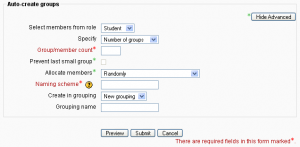Auto-create groups: Difference between revisions
(reformat page, better but still missing some see spot runs :)) |
Helen Foster (talk | contribs) (location of auto-create groups button) |
||
| (One intermediate revision by one other user not shown) | |||
| Line 1: | Line 1: | ||
{{ | {{Groups}}In Moodle 1.9 onwards, groups can be created automatically, with members being allocated randomly or alphabetically according to their first or last name. | ||
In Moodle 1.9 onwards, groups can be created automatically, with members being allocated randomly or alphabetically according to their first or last name. | |||
[[Image:Auto-create groups.png| | [[Image:Auto-create groups.png|thumb|Auto-create groups]]To auto-create groups, click the 'Auto-create groups' button on the groups page (''Settings > Course administration > Users > Groups'' in Moodle 2.0 onwards). | ||
==Settings== | ==Settings== | ||
Latest revision as of 15:31, 12 March 2011
In Moodle 1.9 onwards, groups can be created automatically, with members being allocated randomly or alphabetically according to their first or last name.
To auto-create groups, click the 'Auto-create groups' button on the groups page (Settings > Course administration > Users > Groups in Moodle 2.0 onwards).
Settings
Specify and Group/Member count work together.
You can specify if you would like to create
- x number of Groups or
- each group contain x number of students
- When selecting Members per group the Prevent last small group will allocate additional members to an existing group rather then create a new group with fewer members than x.
A naming scheme can be created automatically. For example: Group @ will create group with a naming scheme Group A, Group B, Group C, etc and Group # will create group with a naming scheme Group 1, Group 2, Group 3. Class @ will create group naming scheme Class A, Class B and etc.
Create in grouping and Grouping name allows you to create a new grouping and allocate the groups to be created to it.
